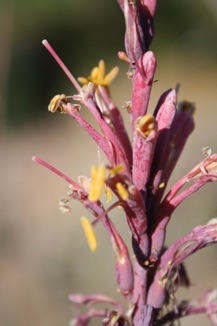Text
August 2010 Newsletter
Indigo Street Pottery Newsletter
In this Issue
1. Indigo Street Pottery Calendar
-
2.Jeff Reich Working on a New Large Sculpture
-
3.Farraday’s University Hospital Health System’s “Promise of the Garden” Commission is Finished!
-
4.Indigo Street Pottery Garden Notes
-
5.Indigo Street Pottery Native Landscaping Summer Interest
Welcome to our monthly newsletter! It is part of our website indigostreetpottery.com , which you can browse from this page if you click on the subjects in the header. We write here about our studio, arts events, projects, studios of our friends, garden musings, and whatever else strikes our fancy. Hope you enjoy it!
1. Indigo Street Pottery Calendar
May 20 - October 3, 2010, Tohono Chul Park A- to-Z, Tohono Chul Park Gallery, Tucson, Arizona tohonochulpark.org
June 11 - August 8, 2010, Arizona Designer Craftsmen 50th Anniversary Exhibition, Mesa Contemporary Arts, Mesa Arts Center, Mesa, Arizona http://www.mesaartscenter.com/index.php/artexhibits/2010springexhibitions1
June 3 - August 14, 2010: A Midsummer Eve: An Exploration of Color and Surface, Meredith Gallery, Baltimore, Maryland www.meredithgallery.com
September - October 2010: Northern Clay Center’s 20th Anniversary Exhibition, with a collaborative piece by Jeff and Farraday, Northern Clay Center, Minneapolis, Minnesota http://www.northernclaycenter.org/see/exhibition_upcoming.php
October - November 2010: Narrative Animal Imagery, The San Luis Obispo Museum of Art, San Luis Obispo, California http://www.sloartcenter.org
November 12 - December 31, 2010: The Artisan Gallery Cup and Mug Invitational: Consider the Cup 2010, The Artisan Gallery, Northhampton, Massachusetts http://www.theartisangallery.com/
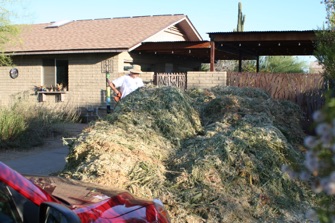
Well, now we’ve gone and done it!
Left photo: Jeff checking out the huge pile of mulched palm trimmings that we had delivered for free from King’s Tree Service, Inc. We’ll compost most of it with layers of goat manure (that we’re getting free from Double Blessings Farm in Apache Junction) to hasten the process. Also, since there is SO MUCH, we’ll use it as mulch on light feeders and established plants, since uncomposted organic mulch takes some nitrogen from the soil as it decays. And decay it will, since we are in high compost season with July and August’s hot, humid, rainy monsoon weather. Our seasonal monsoon usually brings most of the Sonoran desert’s rain for the year with windy, torrential, dramatic thunderstorms.
Right photo: Almost gone! We’ve been wheelbarrowing the shredded palm to the compost areas a couple of hours every day or so, and the mountain is now (almost) a molehill! That’s Farraday in the dust mask. This will make fabulous mulch, and eventually compost.
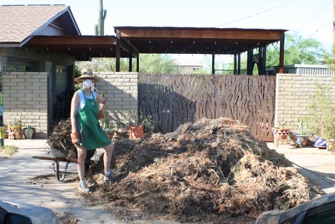
In surfing the web for people’s comments on arid land sunken gardens, we liked these two: One is from Melbourne, Australia and the other from Phoenix, Arizona:
Rachel says: I live in Melbourne (Australia) in a very dry area on clay soil. I have a friend down the road who has put in sunken veggie beds this year and waters each bed once per week by flooding the bed. They also put shade cloth over the patch for very hot days. Their patch looks much better than mine (which has raised beds) and the soil has much more moisture in it. This design also protects from some of the hot dry winds that blow through this area. I plan to put in sunken beds this year now.
PhoenixJen says:
It’s a great question. Sunken beds work wonderfully for hot, arid regions all over the world. Why?
–they create a microclimate that is naturally a couple degees cooler (just like basements are cooler than the rest of the house)
–they allow for the collection of rainwater
–they protect the above ground parts of plants from hot winds and the root zone from burning temps
–in many hot, arid climates, the soil is alkaline with high salinity. When salty soil is watered, the salts tend to migrate to the highest point – with raised beds, that’s the root zone – which just adds to the problem of growing plants in a hot, arid climate.
–sunken beds also attract more plant litter than raised beds thus naturally allowing for soils to build themselves up over time – something most deserts desparately need.
I’ve done sunken in vegetable gardens in Phoenix for a few years now and am really happy with the results. Even though my garden keeps getting bigger, my water bill doesn’t grow that much because I’m building soil and retaining water in my sunken beds. Oh – and no – my beds have never flooded out even in the heaviest rains because I’ve built good spongy soil so it just keeps on seeping in. Add a good layer of mulch and you conserve a lot of water and make a microclimate plants LOVE.
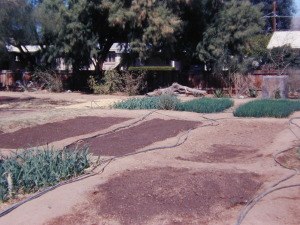

Sunken beds at the Native Seeds/SEARCH Seed Bank garden, Tucson, Arizona and Patagonia, Arizona. http://www.nativeseeds.org/how_to/gardening
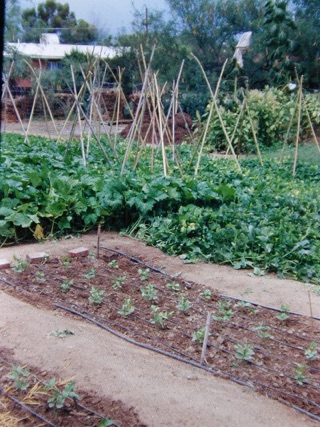
Now that the garden structure is completed and the soil raked clean of construction debris, it is time to dig and form the beds. We are opting for sunken beds, a traditional method of desert gardens for centuries. I first saw an example of this kind of gardening years ago at the Tucson Botanical Gardens where they had an area dedicated to traditional Tohono O’Odham sunken vegetable beds. It was an “ah ha” moment for me. I realized that this mirrored how plants grow in the desert naturally, green and lush in depressions that hold water. It would conserve water to irrigate below grade (especially with a mulch layer) and it would keep the soil much cooler than I could do in raised garden beds. Hot, dry wind blows over the tops of plantings rather than right into the sides. Fortunately, this is an option for us because we have decent soil depth without the boulders or caliche underlayment that exist in many areas of the desert.
Here are some photos of the kind of traditional sunken beds that inspired us. They are from Native Seed/SEARCH‘s website http://www.nativeseeds.org/how_to/gardening .
So now that the construction of our vegetable structure is finished, we are digging the sunken beds. They look pretty deep now because we haven’t added compost or any other amendments to the native soil yet. The bed depth will also allow for a thick mulch layer around the plantings.
Clockwise from above, left: 1. Using water to check if a bed is level. 2. Almost done digging the beds.
3. The garden structure seen through our native wildscaped yard.
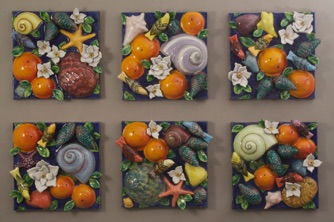
3. University Hospital Health System’s “Promise of the Garden” Commission is Finished!
Farraday’s ceramic wall piece, “Promise of the Garden”, is finished! It was commissioned by Trudy Wiesenberger, Curator of Art since 1988 for the University Hospital Health System of Cleveland, Ohio. The collection is home to over 2,000 pieces of original art and Trudy has been a recipient of the Cleveland Arts Prize for her work at University Hospitals. My piece is destined for the new Cancer Hospital, currently under construction. I’ve been working on this six-part boxy wall tile piece for the past number of months. It measures 52 x 35” installed, with each tile being 16” x 16” x 4” deep. Images of this project in-progress, along with notes on the undertaking, have been included in our past newsletters (click on Archived Newsletters at the top of this page, and then click the October 2009, November 2009, December 2009, February 2010, and July 2010 Newsletters).
Left photo: Four tiles fired and finished, two yet to be fired.
Right photo: All six fired, done, hanging and photographed!



Jeff is building a new sculpture, attaching individual sections of “leatherhard” (damp but firm) clay to attain a dynamic form. For these abstract forms, he often draws inspiration from glacial boulder deposits (“glacial erratics”) seen during his childhood in Michigan. Jeff uses a very rough, dark cone 10 clay (Black Mountain Sculpture), and will eventually glaze fire this piece to cone 10 in our West Coast gas kiln.
2. Jeff Reich Working on a New Large Sculpture
-
4.Indigo Street Pottery Garden Notes
5. Indigo Street Pottery Native Landscaping Summer Interest
Even though the weather is at its most extreme this time of year in the Sonoran Desert, there is still summer color and interest. Below, left to right: profusely blooming Tenaza ( Havardia pallens); an unusual red-blooming Agave (Agave polianthiflora); and the beautiful seedpods of the Yellow Orchid Vine (Callaeum macroptera).




